The Costumes of ‘Dune: Part Two’: Behind Austin Butler’s “Vampire-Esque” Looks, Florence Pugh’s “Nun-Like” Headpieces
- Oops!Something went wrong.Please try again later.
- Oops!Something went wrong.Please try again later.
- Oops!Something went wrong.Please try again later.
- Oops!Something went wrong.Please try again later.
- Oops!Something went wrong.Please try again later.

Denis Villeneuve’s Dune: Part Two, starring Timothée Chalamet and Zendaya, had a blockbuster opening weekend in North American theaters.
Veteran costume designer and five-time Oscar nominee Jacqueline West — whose nominations include Dune and (most recently) Killers of the Flower Moon — talks with The Hollywood Reporter about her work creating 4,000 costumes for Villeneuve‘s latest installment of the film franchise based on Frank Herbert’s 1965 novel. An art historian by training, West seamlessly weaves together a vast array of art, cultural and fictional references to fashion to create a richly layered futuristic desert world in Dune: Part Two.
More from The Hollywood Reporter
Box Office: 'Dune: Part Two' Makes Major Gains With Younger Adults
HauteLeMode Fashion Critic Luke Meagher Signs With UTA (Exclusive)
The costumes of new characters Feyd-Rautha Harkonnen (Austin Butler) and Princess Irulan (Florence Pugh) were among the stand-outs. West says that she was inspired by “the circles of hell in Dante [Alighieri’s] Inferno” and H.R. Giger’s biomechanical-style artwork while crafting the black leather and vinyl gothic looks for Feyd-Rautha. Princess Irulan, adds West, is “kind of the voice of reason, so you want her to have a certain intellectual simplicity about her.” That translated into Brutalist and Japanese influences melded with the Bene Gesserits’ “modieval” — which is West’s combination of medieval fashion with a modern twist — and nun-inspired touches, culminating in a spectacular chainmail gown and headpiece for the warrior princess that took two weeks to make. “That dress probably made a lot of eyes roll up in accounting,” says West.
For Dune, you made about 2,000 costumes, and I know this sequel is expanded. Any count of how many costumes you crafted for Dune: Part Two and insights into the breadth of your operation?
Four thousand. That’s not complete costumes; some of those are pieces. We constructed all the jewelry from old antique, ethnic jewelry. We made masks and shoes. We dyed every piece of fabric, bought in natural colors to control our color palette and then printed over it or painted it with gold or dyes. We would roll out bolts of fabric and hand block print them, hand paint them on 50-foot tables. I had Tom Caddy with me, who was also my ager on Killers of the Flower Moon and Dune. He works closely with Matt Reitsma, my textile artist who controls all the dyeing and designs on the linens that the Fremen wear — the cloaks and shawls and veils. The production was absolutely massive, all done in a huge warehouse area at Origo Studios in Budapest, where there were about 80 people with the pattern makers, cutters, seamstresses, fitters, dyers, agers and textile artists.
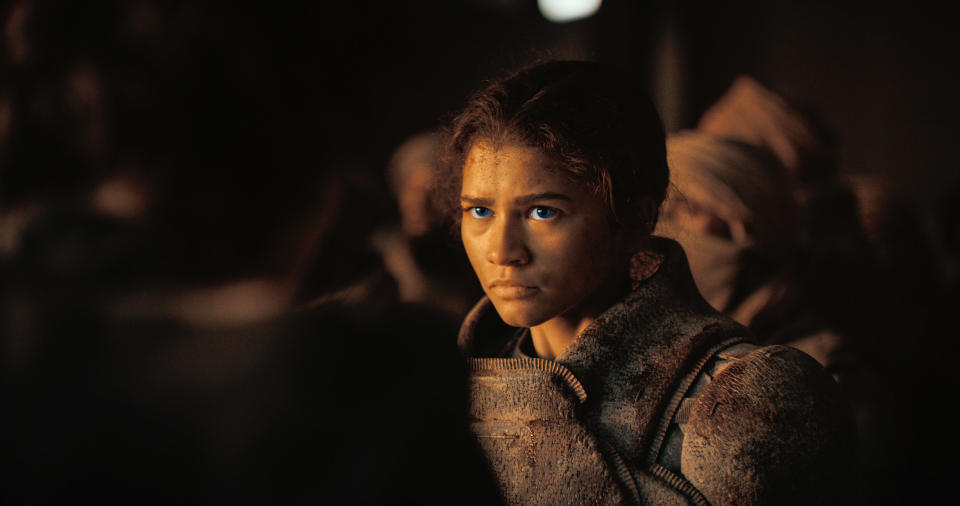
That doesn’t include the specialty costume manufacturers such as Ironhead Studio in Van Nuys, my friends weaving in Italy and a wonderful armorer on an island on the Danube. I had people shopping for fabrics and jewelry all over the world — jewelry from Istanbul and the souks in North Africa, fabrics from Italy, Thailand, the Middle East, China, London, Italy. My jewelry maker from London disassembled all the jewelry we found and recreated what we felt was the modern Tiffany [& Co.] of the Fremen. I also had factories making me really tall shoes for the southern Bene Gesserits, so they would be magnificent when they walked through that door with Lady Jessica, and milliners making headpieces.
Can you speak in more detail about the design aesthetic and the prints?
Dune kind of became a conglomerate desert culture on Atreides 10,000 years in the future. It’s not based on any one nomadic tribe. I drew from the Toaregs, the Bedouins, the Mongols. The art department came up with a Fremen alphabet, which Matt then transposed into designs on the linens. It looks like a combination of Russian and Japanese and Chinese characters and some Arabic, and it’s hand-painted on all the Fremen and southern Bene Gesserit clothing. For the Bene Gesserits, I also drew from medieval art. I got images from Giotto. I’ve always been fascinated by nuns and how they look in different cultures. I just saw Russian nuns around the Revolution in a documentary that my husband was watching this morning, and it reminded me that I also used those images as inspiration. So it’s a composite of what made it to the future, how to meld all those different cultures into one.
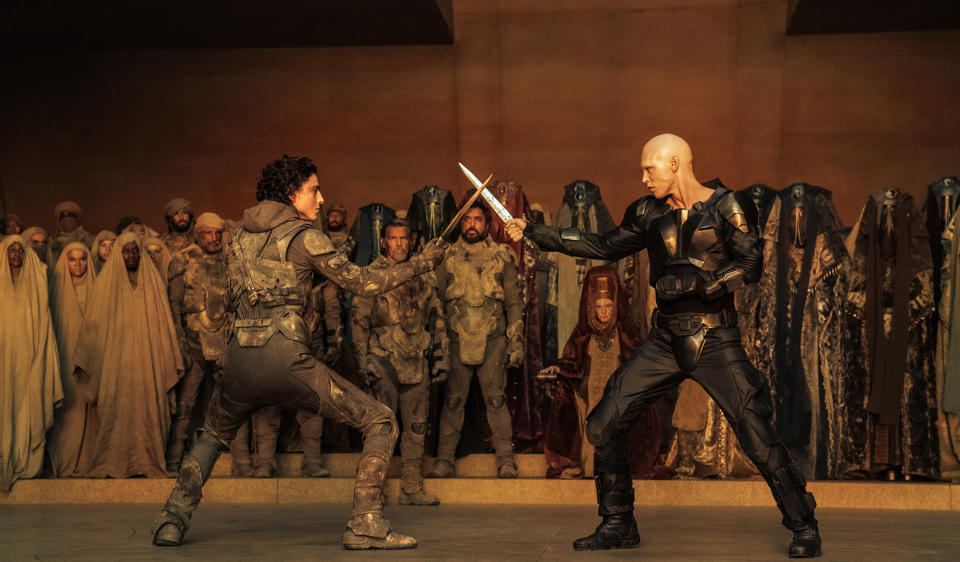
The headpieces and ensembles of Princess Irulan — the daughter of the Emperor (Christopher Walken) — were fantastic. What differentiates her style?
Along with being a princess, she’s a Bene Gesserit, so I had to keep all those elements going. But there’s a certain elegant simplicity to their world. It’s more Brutalist and Japanese. All her beadwork headpieces have a constrictive nun-like look around her face and frame it. That easily went into her warrior princess look when she’s all in chainmail. That’s the whole ‘modieval’ theme I do. It’s got the shape of chainmail armor that you see in old medieval tapestries, but I modernized it by using linked silver chainmail cut with a more ornate lattice look that gave it almost a futuristic, high-fashion McQueen feeling. We had many, many fittings of that chainmail dress so that it fit her body like she was dumped in liquid like Goldfinger, you know? It took about two weeks to construct.
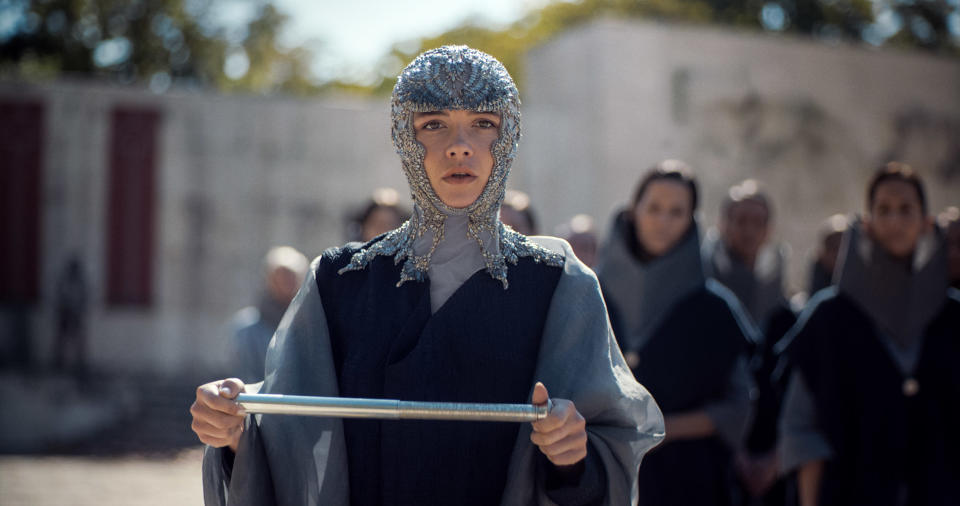
Were you able to reuse some of the costumes from Dune?
Only some of the Sardaukar, and then we had to rebuild a lot of the stillsuits that were totally ruined in all of the battle scenes in Dune. So, we had a factory set up just for replacing parts that had come off or gotten broken and for creating new stillsuits because we needed many more in this film.
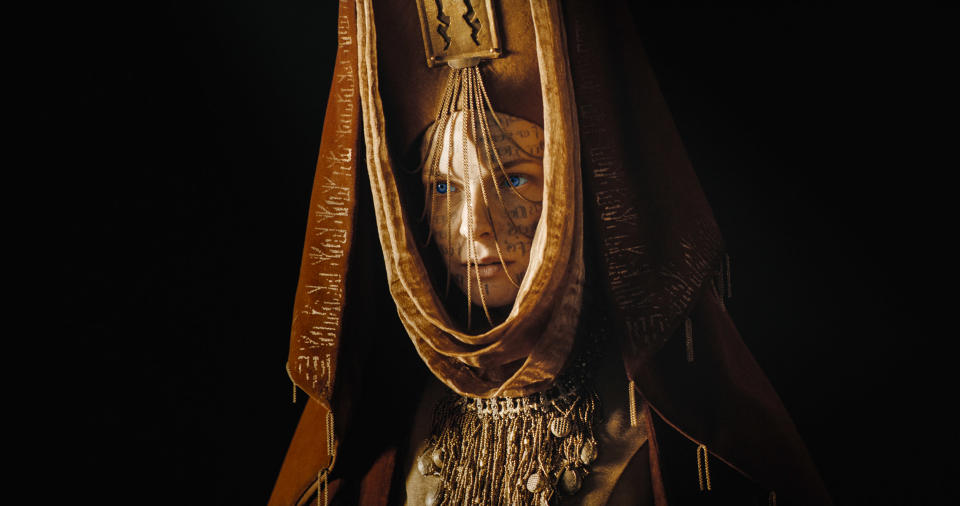
For Dune, you mentioned that some of Rebecca Ferguson’s looks as Lady Jessica were inspired by fashion designer Cristóbal Balenciaga, and I see that Balenciaga inspired a dress on Léa Seydoux as Lady Fenring in Dune: Part Two.
Yes, the black and midnight blue taffeta dress she wears when she first confronts Feyd-Rautha was definitely inspired by Balenciaga, one of my favorites.
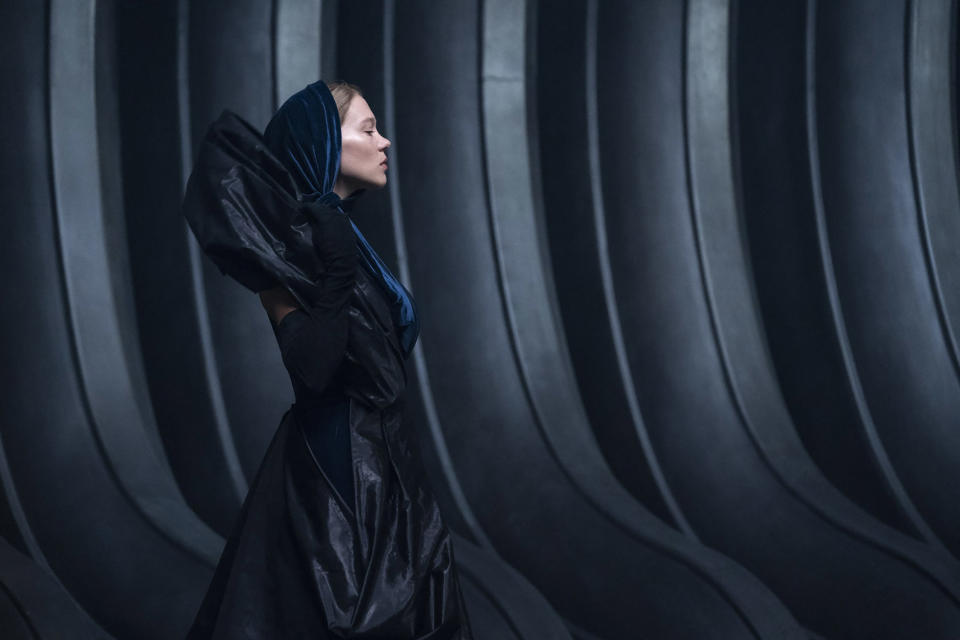
Speaking of Austin Butler as Feyd-Rautha, a new character in this film, can you describe the gothic leather armor in the Harkonnen world?
A lot of the embossing on the leather was [H.R.] Giger-inspired. We didn’t use metal. It was all black stretch leathers and vinyl for that world, with some velvets and coarse wools. The look was gothic and very vampire-esque. The inspirations came from a lot of dark medieval. With Feyd-Rautha, I kept thinking of the circles of hell in Dante’s Inferno. We got these tiny bones, and we coated them all in this kind of leather bath and wove them all together with strips of leather and made those corsets that are amazing. For the picadors in the Giedi Prime gladiator scene, I looked at a lot of drawings by Goya and some incredible stick-like drawings by Jean Cocteau.
What was the biggest challenge on Dune: Part Two?
Creating the army of the Fremen. It was massive. I had to come up with some tricks because we had to make complete stillsuits for 10,000 people. Another challenge was coordinating our incredible international crew in so many different time zones; we had people in Los Angeles, the U.K., Spain, Hungary, Jordan, the United Arab Emirates, Australia … everywhere!
Best of The Hollywood Reporter

